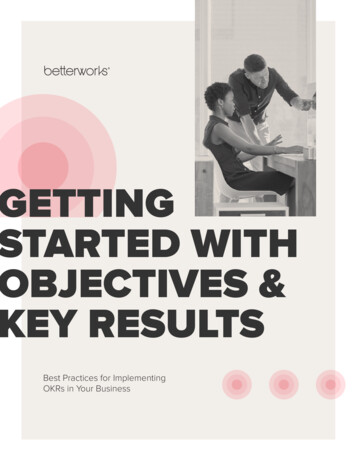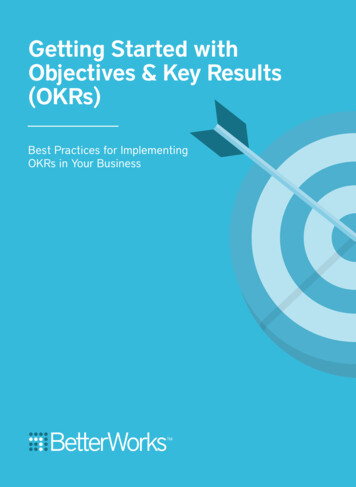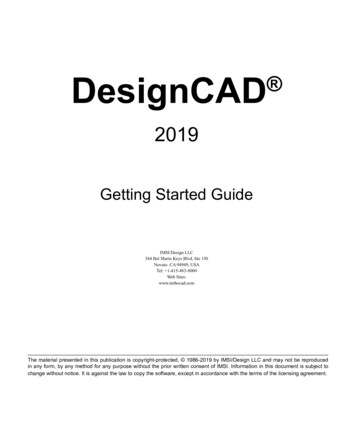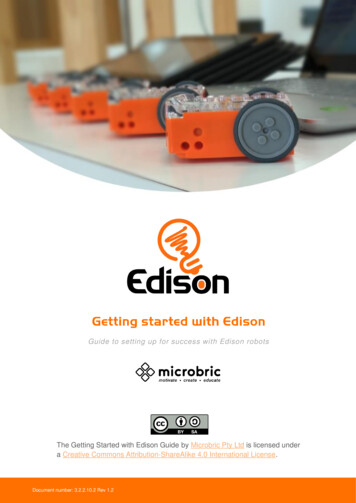
Transcription
GETTINGSTARTED WITHOBJECTIVES &KEY RESULTSBest Practices for ImplementingOKRs in Your Business
Ideas are precious,but they’rerelatively easy.It’s execution that’severything.John Doerr, Partner at KleinerPerkins Caufield & Byers
3Getting Started with Objectives & Key Results (OKRs)TABLE OFCONTENTS04Introduction05The Basics: What are OKRs?08The Right Fit: Organizations That Benefit from OKRs10Setting OKRs: Where to Start?12How John Doerr Explains OKRs13More OKR Examples15Cadence: How Often Should OKRs Be Set?17Engaging a Multi-Generational Workforce with OKRs20Measurement: How Should OKRs Be Scored (or Should They)?21Human Resources: How OKRs Work with Performance Management23Potential Issues and How to Address Them25OKR Input and Tracking26Next Steps: Extending OKRs28About Betterworks
4Getting Started with Objectives & Key Results (OKRs)INTRODUCTIONSince the 1950s, business leaders have embraced a variety ofmanagement techniques designed to improve employee performance.Peter Drucker introduced Management by Objectives (MBOs), a processduring which management and employees define and agree uponobjectives and what they need to do to achieve them. In the early 1980s,S.M.A.R.T. goals and Key Performance Indicators (KPIs) became popularmethods for organizations to set objectives. Then in 1999, John Doerrintroduced Objectives and Key Results (OKRs) to Google, revolutionizingtheir business and cementing OKRs as the de facto standard for aligningcompany and individual goals.A management methodology that helps businesses focus effort onthe same important issues throughout their organization, OKRs havebeen cornerstones to improving operational excellence for industryleaders such as Intel, Oracle, Google and others. As employees leavethese companies for start-ups and other ventures of their own, they arebringing OKRs with them as a way to drive organizational alignment.Understand the value of OKRsThis guidewill help yourorganization:Begin to effectively set OKRsChoose the right OKR softwareOKRsMBOsThe Effective Executiveby Peter Drucker1967S.M.A.R.T.S.M.A.R.T. Wayby George Doran's1981John Doerr introducesOKRs to GoogleKPIs19992020
5Getting Started with Objectives & Key Results (OKRs)The Basics:WHAT ARE OKRs?OKRs are a management methodology that helps companies focusefforts on the same important issues throughout their organization. Whenchampioned by management and implemented throughout a business,OKRs help organizations:Impose disciplined thinking so major goals surfaceInform everyone about what’s importantEnable more accurate communicationEstablish indicators for measuring progressFocus effort and ensure alignmentBecause they are visible toeveryone across the organization,OKRs ensure everyone is workingtoward the same result.
6Getting Started with Objectives & Key Results (OKRs)Key ConceptsWhat isan objective?What I want to accomplishObjectives should be significant, ambitious and aligned to company,departmental or cross-functional goals.Example:Launch a new employee engagement program by end of MarchWhat arekey results?How I will accomplish the objectiveKey results should be measurable, limited in number (3-5 key results)and have a deadline.Example:Send employee engagement survey by January 15Present a strategy for increasing employee engagement by February 20Execute two employee events by end of MarchJohn Doerr, the godfatherof OKRs, talks about goalsfor the enterprise.Watch the videoRead the Q&A
7Getting Started with Objectives & Key Results (OKRs)Common QuestionsHow many OKRs are ideal?Best practices encourage setting three to five key results foreach objective.How should OKRs be communicated?Organizations foster clarity and transparency by hosting Q1, Q2, Q3,and Q4 company-wide meetings and/or enabling OKR dashboardsthat show individual, team, and corporate-level goals with associatedperformance metrics.Once-a-year or every six-months feedbackis not frequent enough to meet the everchanging pace of business.1Paul D. Hamerman and Claire Schooley,Forrester Research
8Getting Started with Objectives & Key Results (OKRs)The Right Fit:ORGANIZATIONS THATBENEFIT FROM OKRsOKRs are a good fit for all types and sizesof organizations because they lead tothe organizational alignment that drivesoperational excellence.LargeEnterprisesIn organizations with many departments, it’s critical for all members of theorganization to be able to provide feedback and input into the goal-settingprocess. By making everyone’s goals transparent and visible, organizationscan attain and maintain alignment. The process of recording operationalgoals (e.g., grow revenue, hire employees, etc.) and aspirational goals (e.g.,how an individual will help the company move into a completely differentspace, revolutionize a market, etc.) drives operational excellence.40 to 40,000Google successfully used OKRs to grow from 40 to 40,000 employees.OKRs can also be effective tools for retaining top talent.
9Getting Started with Objectives & Key Results (OKRs)Small andmedium-sizedorganizationsAs organizations try to determine market fit or maintain competitiveService FirmsIn more fluid reporting structures, such as highly projectized consultingadvantage, OKRs keep employees driving toward the same goals. SMBsmay set and evaluate goals more often than enterprises.organizations where individuals move between projects, it’s important toprovide a way for employees to see and support the work being done byother team members — onsite and offsite.Activity does not always equal progress.Vision without operational excellence justbecomes a dream. Great enterprises marrya huge sense of purpose with amazingoperational excellence.Deep Nishar,former Senior Vice President of Productsand User Experience at LinkedInWatch the video
10Getting Started with Objectives & Key Results (OKRs)Setting OKRsWHERE TO START?The most difficult step for many organizations is committing to the OKRprocess. Businesses should identify an OKR Executive Sponsor who fullyunderstands the benefits of the approach and can help teams that maybe having difficulty getting started or staying on track. This person is oftena chief executive, line-of-business leader, operating officer, or humanresources professional.OKRs are a multi-step process. Businesses may choose to roll out the entireOKR process at once or simply one step at a time. To help ensure success,follow these best practices:OKR bestpracticesAsk employees to individually set OKRs.Establish a time frame after goals are set (one day, one week,etc.) during which managers meet 1:1 with employees toreview OKRs.Establish a time frame after goals are negotiated for alarger group (e.g., all employees in a group) to review andcollectively negotiate departmental OKRs.Establish a time frame after goals are negotiated by thegroup to present OKRs to everyone in the company during anall-hands meeting.It is important to start with and keep teamscentered on three to five objectives at atime with five or fewer key results for eachobjective. Focus will yield the best results foremployees at every level.
11Getting Started with Objectives & Key Results (OKRs)From a practical standpoint, OKRs typically fallinto two large buckets:Two typesof OKRsOperational GoalsThese goals have to do with a company’s metrics, such as productreleases, bookings, hiring, number of customers, etc. They are theorganization’s operating drumbeat. Management will typically set theseat the company level while employees set goals at departmental levels.Aspirational GoalsIn contrast to operational goals, aspirational goals are big-picture ideasabout how a company will change the world. These goals set thescene and are designed to help all employees figure out how they cancontribute to the aspirational ideas. Aspirational goals can come fromany level in the organization.Both sets of represented goals must be as measurable as possible andmeasurement should be linked. For example, “I will accomplish this goalby doing X, Y, and Z.” When both operational and aspirational goalsare visible, all employees know how a company is oriented and alsounderstand that thinking big is required. Additionally, some operationalgoals may be aspirational because one size does not fit all.
12Getting Started with Objectives & Key Results (OKRs)HOW JOHN DOERREXPLAINS OKRsJohn Doerr used a football analogy toexplain OKRs to Google executives:General ManagerObjectiveKey ResultsMake for owners1. Win Super Bowl2. Fill stands to 88%Head CoachHead of PRObjectiveKey ResultsObjectiveKey ResultsWin SuperBowl1. 200 yd/game passing attack2. 3rd ranked defense in NFL3. 25 yd punt return averageFill standsto 88%1. Hire 3 big personality players2. Get 2 Moday night games3. Highlight key playersOffenseDefenseSpecialTeamsScoutsNew ctiveObjectiveObjective200 yd/gamepassing attack3rd rankeddefense in NFL25 yd puntreturn averageHire 3 bigpersonality playersGet 2 Mondaynight gamesHighlight keyplayersKey ResultsKey ResultsKey ResultsKey ResultsKey ResultsKey Results75% completionLess than 100ydpassing pergame3 blocked puntsVisit top 25colleges5 ESPN specialfeaturesHire 10 newcheerleaders
13Getting Started with Objectives & Key Results (OKRs)MORE OKR EXAMPLESTable 1 (previous page) is an example of OKRs that a senior executive mightset. Because employee goals typically cascade from management goals,Table 2 provides examples of line-of-business manager OKRs from variousdepartments across the business.Senior Executive OKRsOperational GoalsImprove FinancialPerformance Close three deals over 10MIncrease CustomerSatisfaction Increase upgrade conversions to 10%Measure EmployeeEngagement Institute bi-annual, company-wide NPS survey Engage customers through features voting (see “innovation” objective)Aspirational GoalsIncrease MarketLeadership Move into the “Challengers” category of the Gartner Magic Quadrants (MQs)Innovation Institute “suggest your own feature” within product by 2/15Accelerate StrategicGrowth Sign partner agreement to expand into Latin America by Q2
14Getting Started with Objectives & Key Results (OKRs)Manager OKRs (Various Departments)Operational GoalsImprove FinancialPerformance Enable digital signatures for purchase ordersIncrease CustomerSatisfaction Grow per day views to 10,000 by personalizing contentMeasure EmployeeEngagement Develop NPS survey by 1/20 Add a systems engineer to each proof of concept Run quarterly phone blitz campaign targeting top 100 customers Automate survey distribution and results collection by 2/15 Read out results within 30 daysAspirational GoalsIncrease MarketLeadershipInnovation Meet with Gartner analysts publishing relevant MQs Get three reference customers to speak with Gartner analyst Trial three new similar product features per quarter, enable users to vote Collect results and solicit other ideas Build most popular features into Q2 product releaseAccelerate StrategicGrowth Engage with five possible partners Conduct due diligence by Q1 Work closely with legal to develop contract terms by Q2Well-developedOKRs are verypowerful toolsEmployees across the company, even those located globally, can link theirgoals to the corporate goals, knowing that their work is having a directimpact on the success of the business. Moreover, corporate goals shouldbe inclusive of ideas that are created at the individual contributor level.This keeps senior leadership in tune with the organization.
15Getting Started with Objectives & Key Results (OKRs)Cadence:HOW OFTEN SHOULDOKRs BE SET?Most organizations work through OKRs quarterly.Others set OKRs in monthly or six-week intervals.It is important to be sure the cadence matchesthe stage and culture of the business. A quarterlycadence may be too long for a very early stagecompany trying to determine its market fit. Itmay also be too long for a unit within a largercompany that is working to substantially changeits delivery processes.The interval is important because the relevance of goals diminishes in fastpaced environments. Whether the cadence is six weeks, one month, orquarterly, businesses typically see huge operational wins when they move fromannual assessments to more frequent goal setting. Moreover, because agilityis a key indicator of business success, companies should consider providing away for employees to set, show progress, and get feedback on goals daily.OKROKROKROKR
16Getting Started with Objectives & Key Results (OKRs)In “Start-Up Speed,” Kristen Gil, VP of Business Operations atGoogle, explains some of the changes Google instituted to help itoperate at small business speed, even as it grew.Creating quarterly OKRs has been part of Google’s culture sinceboard member John Doerr introduced the concept in 1999. Morerecently, however, we’ve elevated their importance and are using thequarterly OKR all-hands meeting (which is led by Larry Page and othercompany leaders) as a rallying point for all employees. Team by team,the leaders lay out their objectives and how they’ll measure success.Afterwards, they’re posted for anyone within the company to see.A recent OKR objective for our search team was to improve theworld’s information and make it universally accessible and useful,which restates and reiterates the company’s mission statement. Thekey results underneath that objective included metrics and projectsfor the quarter, many of which span a number of teams, ensuring awell-coordinated push toward a shared goal. Having these sharedgoals also has the benefit of helping prevent the formation of silos—always a concern as companies grow.2Kristen Gil, VP of BusinessOperations at Google
17Getting Started with Objectives & Key Results (OKRs)ENGAGING A MULTIGENERATIONAL WORKFORCEWITH OKRsThe workforce is on the cusp of significantchange as many older employees will retirein the next 10-15 years. The challenge forbusinesses is to replace this group thatcurrently holds leadership positions with newtalent that keeps innovating.CEB’s Talent Report, based on millions of assessments of employeesworldwide, identified six motivational factors that any manager must beaware of to engage and retain a multi-generational workforce.3
18Getting Started with Objectives & Key Results (OKRs)In the PWC “Millennials at Work” report, authors offered six suggestionsto businesses to help ensure they understand the millennial generationand are acting to attract and inspire the best of them:Understand thisgenerationUse metrics to segment the workforce to better understand andGet the ‘deal’ rightEnsure everyone knows what is expected.Help millennials growUnderstand personal and professional goals.Feedback, feedback,and more feedbackGive real-time, honest feedback.Set them freeProvide flexibility yet clear instruction and concrete targets.Encourage learningDeliver continuous training and development.Allow fasteradvancementValue results, not just seniority.Expect millennials to goBuild churn into business plans.4address generational differences and tensionsOKRs are an ideal way to help organizationsmanage and keep generational groups workingtoward common objectives.By establishing clear goals and making them visible company wide,everyone on the team gains a better understanding of what tasks areimportant to whom, how individuals prioritize them, what motivatesemployees across generations and how the workforce can team toachieve success.
19Getting Started with Objectives & Key Results (OKRs)Motivation by Generation Numbersrepresent percentile rankingBOOMERSGEN X’ERSMILLENNIALSWhat gets me out of bed in the tile3050545970What brings me back the next day?AutonomyPercentile3041 4257Progression70Percentile3040535970What will make me stick around?Personal Principles30 32Percentile427050Personal Growth30Percentile32485470
20Getting Started with Objectives & Key Results (OKRs)Measurement:HOW SHOULD OKRs BESCORED (OR SHOULD THEY)?Historically, Google has emphasized the importance ofdefining scoring criteria for each key result. In fact, thecompany takes an ambitious approach to measuringOKRs. Executives recommend that employeesconsistently achieve scores of 60-70%. Individualscores for employee goals are automatically calculatedby a proprietary application.Because the achievement of individual OKRs should not be (and typicallyRead about Google’sisn’t) directly related to a performance review or compensation, scoringscoring practices,OKRs may become unnecessary. Depending on your company culture,and how OKRsself-assessment, and peer-assessment models may be as effective in goalhelped Google growmeasurement strategies. In cases where companies have chosen not tofrom 40 to 40,000score goals, employees take time for self-reflection. They think deeply aboutemployees. what they achieved and did not achieve before setting a next set of goals.A retrospective look at how employee skillsalign with job requirements may be useful,but it doesn’t drive the results that thebusiness cares about.” 5Paul D. Hamerman and Claire Schooley, Forrester Research
21Getting Started with Objectives & Key Results (OKRs)Human Resources:HOW OKRs WORK WITHPERFORMANCE MANAGEMENTAs a best practice, OKR completion should be decoupled fromperformance evaluations so individuals feel free to take more innovativerisks than they might otherwise. Separating the two also means employeeswon’t spend time trying to game the system to reap rewards. OKRs aredesigned to bring alignment, focus and better coordination to companies.6That said, the level of engagement you show with OKRs and your impactdelivered through OKRs can very well be considered by your managerduring performance evaluations.Refactor your performance processso that you can continuously measureand recognize employees forachievements and outcomes that drivebusiness success.”Paul D. Hamerman and Claire Schooley,Forrester Research
22Getting Started with Objectives & Key Results (OKRs)The question may also arise as to whetherhuman resources (HR) should be responsiblefor the OKRs process in the organization.According to Josh Bersin, Principal and Founder of Bersin by Deloitte,Deloitte Consulting LLP, “The HR role is a difficult one today becauseleaders are being asked to continue to do their job of making surethe business and employee interactions are fair, in compliance, anddon’t create risk for the business. HR professionals are also now beingasked to be innovators. I think HR teams can be great facilitators totheir businesses without having to ‘own’ every domain.”Although HR may not be the champion for the business, HR staffcan actively help to make the transition to the OKRs process and theongoing adoption of OKRs a smooth process.What you’re going to find in the reallyhigh-performing companies is thatHR is really a people-optimizationfunction. They are looking at the waypeople work. The way they set goals.The way work gets done.Josh BersinWatch the videoRead the Q&A
23Getting Started with Objectives & Key Results (OKRs)POTENTIAL ISSUES ANDHOW TO ADDRESS THEMInevitably, there will be some trial and error as executives, managers, andemployees adopt the OKRs process. Because one size does not fit all, the OKRsponsor and program lead should be aware of individuals and teams findingthe most success and those having the least success with OKRs, and work tounderstand why. Critical assessment, especially in the first few quarters of a rollout, and modifications to the process will be keys to on-going success.As adoption grows, OKR champion JohnDoerr and others recommend addressing thefollowing potential issues early:Lack of supportacross the entireorganizationFor OKRs to be effective, goals must be supported by the entireLack ofaccountabilityJust setting goals isn’t enough. Goals must be measurable or haveorganization. Every team and working group should agree on goalsand priorities.quantifiable targets. From shipping a certain number of productsto hitting a release schedule, teams have to be able to track andmeasure the goals they set.Lack of reality,especially timingGoals should be aggressive yet realistic. Individuals and teams shouldLack of riskOKRs should not be tied to bonus payments. Organizations shouldstretch, but not to the point of breaking.think about using OKRs to build a bold, risk-taking culture.
Getting Started with Objectives & Key Results (OKRs)“Leaders must evaluate employees holisticallyby discussing with employees how they havemet their goals, their contributions to the team,how they have worked collaboratively to drivebusiness value, and how they have embracedthe organizational culture.”7Paul D. Hamerman and Claire Schooley,Forrester Research24
25Getting Started with Objectives & Key Results (OKRs)OKR INPUT AND TRACKINGAs a business grows, it requires a more robust enterprise goalmanagement platform to capture, share, and track progress toward keyobjectives and results.Any business evaluating software to track OKRs or managegoal setting should ask a potential provider whether its offeringincludes the following critical goal management capabilities:Critical goalmanagementcapabilities:Does the software support both bottoms-up origination of OKRs withindividuals, as well as top-down, cascading processes where managersdefine OKRs for their direct reports?Can OKRs cross teams to enable horizontal alignment and flagdependencies, or must they be set up separately for each team asdictated by the organizational chart?How easy is it to access updated OKRs?Are there mobility options?Can anyone see a history of how OKRs change over time?Is charting available?How does the software encourage behaviors, such as frequentcheck-ins, to keep goals and progress fresh?How easy is it for colleagues to support, collaborate, encourage,and comment on one another’s goals?What engagement techniques exist in the software to drive adoption,usage, and re-engagement? Are there notifications, social gestures,and feedback loops?What dashboard capabilities exist to serve as an early warning systemfor the company? At the executive level, the manager level, andindividual level, what types of notifications are available?What examples of enterprise-scale deployments has thesoftware served?Does the software try to combine many other features, or does it reallysolve the OKRs problem deeply? And most importantly, will employeesactually want to use the tool, rather than it being forced on them?
26Getting Started with Objectives & Key Results (OKRs)Next Steps:EXTENDING OKRs TO FURTHEROPERATIONAL EXCELLENCEToday’s best practices for managing and tracking business objectivesinclude modern Goal Science thinking based on five pillars:ConnectedVertical/horizontal alignment and claritySupportedWorking transparently with praise and recognitionProgress-BasedFrequent, measurable feedback and frequent winsAdaptableFlexibility to respond to changing goals and business needsAspirationalGreater achievement and encourage excellence
27Getting Started with Objectives & Key Results (OKRs)Modern goal-setting platforms support these practices by ensuring goalsare easy to set, manage, track, and see throughout an organization.Sources:1Forrester Research. “Disrupt the Employee Performance Process to Align with Business and CustomerOutcomes,” Paul D. Hamerman and Claire Schooley, July 2, 2014.2Think with Google. “Start-Up Speed,” January 2012.3CEB. “The CEB Talent Report: Big Data Insight and Analysis of the Global Workforce.” SHL TalentMeasurement, June 2014.4PWC. “Millennials at Work. Reshaping the Workplace,” 2011.5Forrester Research. “Disrupt the Employee Performance Process to Align with Business and CustomerOutcomes,” Paul D. Hamerman and Claire Schooley, July 2, 2014.6Forrester Research. “Disrupt the Employee Performance Process to Align with Business and CustomerOutcomes,” Paul D. Hamerman and Claire Schooley, July 2, 2014.7Forrester Research. “Disrupt the Employee Performance Process to Align with Business and CustomerOutcomes,” Paul D. Hamerman and Claire Schooley, July 2, 2014.
28Getting Started with Objectives & Key Results (OKRs)ABOUTBETTERWORKSBetterworks helps companies executewith agility on their business objectivesthrough OKR alignment, commitment andtransparency, empowering people to performat the highest level, from anywhere.Our combined OKR, Continuous PerformanceManagement and Engagement solutiondelivers the critical insights, conversations,feedback and recognition needed toengage and develop today’s workforce.With Betterworks, organizations can ensurealignment and accountability across theenterprise for sustained competitiveadvantage. The formula for BetterBased in Redwood City, CA Betterworks hasreceived more than 65M in funding and isused daily by employees and managers from119 countries in more than 20 languages.Click here for more resources around OKRs,and for more information about the latestpeople management strategies and bestGoals and AlignmentAlign teams and individualgoals to the organization's topprioritiesConversations, Feedback,Recognitionpractices visit our resources library.Facilitate continuous coaching,skill development, goal progress CalibrationUp-to-date, real time insightsinto employee performanceInsights and AnalyticsActionable program andworkforce insights, at a glance EngageIntegrationsListen to employees at allstages in their lifecycle andtake actionMeeting teams wherethey work Copyright 2013-2020 Betterworks. All rights reserved. Various trademarks held by their respective owners.999 Main Street, Redwood City, CA 94063844.438.2388 hello@betterworks.com
Getting Started with Objectives & Key Results (OKRs) 11 From a practical standpoint, OKRs typically fall into two large buckets: These goals have to do with a company’s metrics, such as product releases, bookings, hiring, number of customers, etc. They are the organization’s operating drumbeat. Management will typically set these










